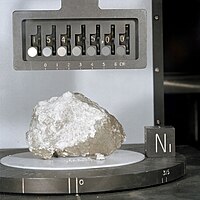
Photo from wikipedia
The Hayabusa2 spacecraft investigated the C-type (carbonaceous) asteroid (162173) Ryugu. The mission performed two landing operations to collect samples of surface and subsurface material, the latter exposed by an artificial… Click to show full abstract
The Hayabusa2 spacecraft investigated the C-type (carbonaceous) asteroid (162173) Ryugu. The mission performed two landing operations to collect samples of surface and subsurface material, the latter exposed by an artificial impact. We present images of the second touchdown site, finding that ejecta from the impact crater was present at the sample location. Surface pebbles at both landing sites show morphological variations ranging from rugged to smooth, similar to Ryugu’s boulders, and shapes from quasi-spherical to flattened. The samples were returned to Earth on 6 December 2020. We describe the morphology of >5 grams of returned pebbles and sand. Their diverse color, shape, and structure are consistent with the observed materials of Ryugu; we conclude that they are a representative sample of the asteroid. Description Obtaining and returning samples of Ryugu The Hayabusa2 mission investigated the nearby carbonaceous asteroid Ryugu and collected samples for return to Earth. Tachibana et al. describe Hayabusa2’s second sample collection, which picked up material that was excavated from Ryugu’s subsurface by an earlier impact experiment. By analyzing footage from both touchdown events, the authors determined the morphological properties of small pebbles on the asteroid. After the sample return capsule was opened on Earth, they found the chambers contain pebbles with properties consistent with the touchdown locations, indicating that they are representative samples of Ryugu’s surface and subsurface. —KTS Hayabusa2’s second touchdown on Ryugu obtained material from the asteroid’s subsurface, which was then returned to Earth.
Journal Title: Science
Year Published: 2022
Link to full text (if available)
Share on Social Media: Sign Up to like & get
recommendations!